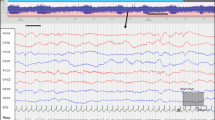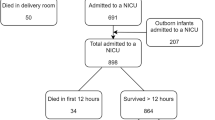Abstract
The incidence of sudden infant death syndrome has been found to be consistently higher in preterm and low birth weight infants than in infants born at term. Failure to arouse from sleep is one possible mechanism for sudden infant death syndrome. This study compared the arousal responses to nasal air-jet stimulation in a longitudinal study between groups of healthy preterm and term infants. Preterm infants (n = 9) were born at 31–35 wk gestation with normal birth weights for gestational age and studied on three occasions: a preterm study at 36 wk, at 2–3 wk post-term, and at 2–3 mo post-term. Term infants (n = 22) were born at 37–42 wk and were studied at 2–3 wk and 2–3 mo post-term. Arousal thresholds were determined in both active sleep (AS) and quiet sleep (QS). In preterm infants, there was no state-related difference in arousal thresholds at either the 36 wk or 2–3 wk study; however, at 2–3 mo, arousal threshold was significantly greater in QS than AS (p < 0.05). In contrast, in term infants, arousal thresholds were significantly elevated in QS compared with AS at both 2–3 wk and 2–3 mo (p < 0.001). Arousal thresholds in AS were not different between the two groups of infants, with both groups of infants remaining readily arousable. However, in QS at 2–3 mo, arousal thresholds were significantly lower in the preterm infants (p < 0.05). This study has demonstrated that arousability is altered by gestational and postnatal age. The lower arousability that characterizes QS in term infants regardless of age is not evident in preterm infants until 2–3 mo post-term age.
Similar content being viewed by others
Log in or create a free account to read this content
Gain free access to this article, as well as selected content from this journal and more on nature.com
or
Abbreviations
- SIDS:
-
sudden infant death syndrome
- QS:
-
quiet sleep
- AS:
-
active sleep
- HR:
-
heart rate
- EMG:
-
electromyogram
References
Byard RW 1995 Sudden infant death syndrome: a ‘diagnosis' in search of a disease. J Clin Forensic Med 2: 121–128.
Grether JK, Schulman J 1989 Sudden infant death syndrome and birth weight. J Pediatr 114: 561–567.
Hoffman HJ, Hillman LS 1992 Epidemiology of the sudden infant death syndrome: maternal, neonatal, and postneonatal risk factors. Clin Perinatol 19: 717–737.
Malloy MH, Hoffman MA 1995 Prematurity, sudden infant death syndrome and age of death. Pediatrics 96: 464–471.
Hoffman HJ, Damus K, Hillman L, Krongrad E 1988 Risk factors for SIDS: results of the National Institute of Child Health and Human Development SIDS Cooperative Epidemiological Study. Ann N Y Acad Sci 533: 13–30.
Peterson DR 1966 Sudden unexpected deaths in infants: an epidemiologic study. Am J Epidemiol 84: 478–482.
Standfast SJ, Jereb S, Janerich DT 1979 The epidemiology of sudden infant death syndrome in upstate New York. JAMA 241: 1121–1124.
Hunt CE 1992 The cardiorespiratory control hypothesis for sudden infant death syndrome. Clin Perinatol 19: 757–771.
Kahn A, Groswasser J, Rebuffat E, Sottiaux M, Blum D, Foerster M, Franco P, Bochner A, Alexander M, Bachy A, Richard P, Verghote M, Le Polain D, Wayenberg JL 1992 Sleep and cardiorespiratory characteristics of infant victims of sudden death: a prospective case-control study. Sleep 15: 287–292.
Schectman VL, Harper RM, Wilson AJ, Southall DP 1992 Sleep state organization in normal infants and victims of sudden infant death syndrome. Pediatrics 89: 865–870.
Read PA, Horne RSC, Cranage SM, Walker AM, Walker DW, Adamson TM 1998 Dynamic changes in arousal threshold during sleep in the human infant. Pediatr Res 43: 697–703.
Loy CS, Horne RSC, Cranage SM, Chau B, Adamson TM 1998 Immunisation has no effect on arousal from sleep in the newborn infant. J Paediatr Child Health 34: 349–354.
Anders T, Emde R, Parmelee A 1971 A Manual of Standardized Terminology, Techniques and Criteria for Scoring of States of Sleep and Wakefulness in Newborn Infants. BRI Publications, Los Angeles, CA, 1–11.
Curzi-Dascalova L, Mirmiran M 1996 Manual of Methods for Recording and Analyzing Sleep-Wakefulness States in Preterm and Full-Term Infant. INSERM, Paris, 1–162.
Cornsweet T 1962 The staircase method in psychophysics. Am J Psychol 75: 485–491.
Newman NM, Frost JK, Bury L, Jordan K, Phillips K 1986 Responses to partial nasal obstruction in sleeping infants. Aust Paediatr J 22: 111–116.
Newman N, Trinder J, Phillips K, Jordan K, Cruikshank J 1989 Arousal deficit: mechanism of the sudden infant death syndrome?. Aust Paediatr J 25: 196–201.
Trinder J, Newman N, Kay A, Whitworth F, LeGrande M, Jordan K 1989 Arousal from sleep and the sudden infant death syndrome. In: Bond N, Siddle D (eds) Psychobiology: Issues and Applications. Elsevier Science Publishers BV, North Holland, 325–335.
Trinder J, Newman NM, Le Grande M, Whitworth F, Kay A, Pirkis J, Jordan K 1990 Behavioural and EEG responses to auditory stimuli during sleep in newborn infants and in infants aged 3 months. Biol Psychol 31: 213–227.
Kohyama J 1998 Sleep as a window on the developing brain. Curr Probl Pediatr 28: 69–100.
Hoppenbrouwers T 1987 Sleep in infants. In: Guilleminault C (ed) Sleep and Its Disorders in Children. Raven Press, New York, 1–15.
Sheldon SH, Spire JP, Levy HB 1992 Normal sleep in children and young adults. In: Sheldon SH, Spire JP, Levy HB (eds) Pediatric Sleep Medicine. WB Saunders, Philadelphia, 14–27.
Scher MS, Steppe DA, Dahl RE, Asthana S, Guthrie RD 1992 Comparison of EEG sleep measures in healthy full-term and preterm infants at matched conceptional ages. Sleep 15: 442–448.
Horne RSC, Andrew S, Mitchell K, Cranage S, Chau B, Adamson TM 1998 Effects of apnoea of prematurity on arousal from sleep. Proc 5th Sudden Infant Death International Conference, Rouen, France, Abstract 194
Anders TF, Keener M 1985 Sleep-wake patterns in full-term and premature infants during the first year of life. Sleep 8: 173–192.
Kahn A, Grosswasser J, Sottiaux M, Franco P, Dramaix M 1993 Prone and supine body position and sleep characteristics in infants. Pediatrics 91: 1112–1115.
Acknowledgements
The authors thank the staff of the Newborn Services and the Moorabbin Birth Centre of the Monash Medical Centre and the parents and infants who participated in this study. We also thank Associate Professor Adrian Walker and Professor Richard Harding for their comments on drafts of this manuscript.
Author information
Authors and Affiliations
Additional information
Supported by the National SIDS Council of Australia Ltd.
Rights and permissions
About this article
Cite this article
Horne, R., Sly, D., Cranage, S. et al. Effects of Prematurity on Arousal from Sleep in the Newborn Infant. Pediatr Res 47, 468–474 (2000). https://doi.org/10.1203/00006450-200004000-00010
Received:
Accepted:
Issue date:
DOI: https://doi.org/10.1203/00006450-200004000-00010
This article is cited by
-
Childhood sleep: assessments, risk factors, and potential mechanisms
World Journal of Pediatrics (2024)
-
Early development of sleep and brain functional connectivity in term-born and preterm infants
Pediatric Research (2022)
-
Spontaneous and apnea arousals from sleep in preterm infants
Pediatric Research (2021)
-
Sleep and prematurity: sleep outcomes in preterm children and influencing factors
World Journal of Pediatrics (2019)
-
Risk of cardio-respiratory abnormalities in preterm infants placed in car seats: a cross-sectional study
BMC Pediatrics (2005)



